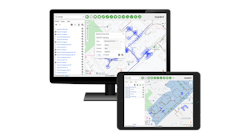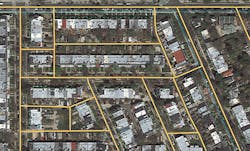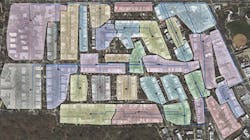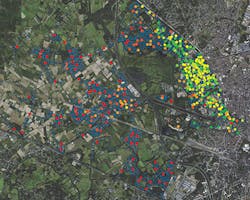An FTTx deployment is a big investment. However, a well-executed design phase can result in significant savings. In order to take advantage of these savings, the right processes and tools need to be introduced. This article describes some of the things that should be kept in mind when making adjustments to your current design process. Adopting some of these changes will lead to a cheaper and more optimized network deployment process.
An ideal workflow for designing an FTTx network is composed of the following 6 steps.
Step 1. Decide on the type of network you want to build.
Step 2. Determine where you want to build your network.
Step 3. Continue with the high level outside plant (OSP) design of the network.
Step 4. Verify the high level design in the field to make sure that the network is constructible. Fine-tune and correct the design where needed.
Step 5. Create the low-level design with all fiber level splice connections and labelling.
Step 6. Release this low level design to the construction teams.
Though this seems straightforward, the right tools and process in this workflow are crucial to optimizing your FTTx network design. Coordinating those tools properly and imposing the correct processes is key. Every transition between tools is a potential point of failure.
It’s not simply the exchange of data from one system to another that needs to be streamlined. The handovers that occur between the many parties involved in an FTTx project also need to be addressed.
Automated planning and design software solutions require detailed GIS information. More than in a manual design, this data needs to be perfect to allow the automatic calculation of the optimal design.
Goals of Optimization
Optimizing an FTTx network design should lower the costs of an FTTx deployment, with the savings realized during the design process, network construction, and network operations.
The important questions to ask yourself are What does the optimal network look like? Is it the cheapest network, or is it a network that is easy to deploy? It can be either of these options, but above all, it must be constructible.
The term "optimization" is not specific to a particular aspect of FTTx design. Is your objective to optimize the CapEx, OpEx, ease of deployment, or all of the above?
There are also many different design guidelines to follow, and external parties such as equipment vendors and subcontractors impact the construction of the design and the permits granted.
The last several years have seen a rise in the number and variety of tools available that can help to optimize your network design. Integrating the right tools into your design process will lead you to the ideal end result.
These new tools should be able to offer:
• The ability to capture field information with mobile mapping technology and mobile applications to avoid errors.
• The option to choose a physical network inventory solution as the basis for your design process. This is necessary to steps in the project such as construction and as-built documentation. It’s critical to adapt a single data storage system that gives you a precise, correct view of your design since several parties are involved in the execution of an FTTx project. Streamlining the processes involved in data interaction is an absolute must to ensure that the correct data is available to the right parties at the right time. Ideally, all parties have access to data housed in one central location.
• The choice to introduce a network planning and design tool to automate the network design process. The algorithms used form the core of the optimization. These determine the level of optimization that can be achieved by the software. There is a trade-off with calculation speed, but the benefits are significant when compared to manual design.
• Functionality to integrate all tools. This guarantees data integrity and avoids duplicate work.
Both a manual and automated design should create a constructible network. The automated design should be cost-optimized based on the design restrictions specified by the user.
Choosing the Right Architecture
The network architecture you choose has a significant impact on cost. Many crucial choices must be made: PON vs. P2P, aerial vs. underground, splitter sizing, and more. Determining which type of architecture will be the best for your deployment area is not a straightforward task. And if you intend to deploy in several locations, the optimal architecture will vary by location. Deploying in a rural area versus an urban area involves different type of networks, along with coordinating with existing infrastructure such as poles or conduits. Choosing the right architecture for a specific location will lower the construction costs.
Thankfully, today’s network planning and design software can be used to compare design rules by geography, so you can select the one most suited to your area. Once that is determined, the ideal software should automatically calculate the cost of the network using the specified rules and GIS data. All of this makes it more accurate than simple Excel modeling or extrapolation.
Finally, you need to remember that the cheapest network might not have any redundancy or spare capacity needed to be future-proof. That’s why it’s critical to determine how much extra investment is needed to include spare capacity at different levels of the network.
By including automation software in this process, you can easily test different choices related to the questions mentioned earlier, and make educated decisions regarding its design.
Optimizing your FTTx network design already starts in the strategic planning stage. Evaluate different architectures to find the most cost-effective one for your specific area of interest.
Garbage In, Garbage Out
Because every FTTx network is different, the best automated software takes into account 3 things: 1) specific design guidelines, 2) restrictions implied by the equipment and technology, and 3) the local conditions of the area into account.
But, what seems obvious to a human designer might not be so straightforward to an automated tool. Because of this fact, more detailed input data is required compared to manual or non-optimized design. Accurate information concerning GIS, cost, and network architecture, needs to be gathered before the design process can begin. You will need to collect premises to pass, existing infrastructure to reuse (conduits, manholes, poles, etc.), the OLT location(s), and ROW, before starting the design. Detailed information including cost to cross a road and trenching method for each side of the road should be collected. Though it can be tedious, it’s important to load all of the information you have about materials and labor costs, equipment, and activities, involved in the FTTx project. Incorrect costing information will naturally have an impact on the design.
As we said previously, it is crucial to verify your design by going into the field. After you return, incorporate the changes mandated by the field visit into the automated software to avoid costly and inefficient design changes.
A common misunderstanding of automated and optimized network design is that it will remove the need for personnel to go into the field at all. While this is not possible, the right automated software can limit the frequency of field visits and streamline the processes as much as possible.
Conclusion
By introducing the right tools and processes, each stage of the FTTx project can be optimized. Design automation tools can be a crucial part in this, both in the strategic planning stage as well as during the design stage.
In today’s complex deployment world, accurate input data is required for optimized network design. And while gathering this data can delay the start of the project, this information is essential to allow the automated software to make the best and most optimized decisions. It also helps you avoid making suboptimal changes later on in the project.
In the end, shifting from manual to optimized and automated network design is the best decision, as it will lower the design time, avoid human errors, and, most importantly, decrease the construction costs.
One such software solution is called FiberPlanIT. Integrated with your current processes, it can give you the power to take control of your network designs and allows you to save in planning time and construction costs.








